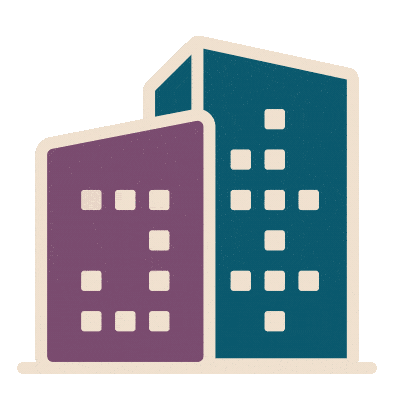What’s new in WELL v2: Community
Every space has a unique community in which individuals work, live, play, socialize and learn. Communities aren’t just defined by a cluster of buildings and they don’t just exist at the neighborhood scale. They encompass diverse groups of people linked by social ties, joint experiences and shared access to services and amenities, all within a common setting - whether it be on one floor of a building or across an entire organization. The Community concept in WELL v2™ pilot promotes policy and design strategies that enable all individuals to access, participate and thrive within a space.
How is community related to health?
Supporting community well-being must start with supporting individual health. The global, national and local conditions that influence individual health are known as the social determinants of health, which include the built or “physical” determinants. According to the World Health Organization (WHO), social determinants such as age, socioeconomic status, race, gender or gender identity, disability status, cultural background and residential location are often the basis for unequal distribution of power, access or resources. This in turn leads to health disparities, wide differences in health status between populations. A key contributor to health disparities is low health literacy - a lower ability to access, understand and apply health information.
A culture of health
To help address these challenges, the Community concept guides projects to create a “culture of health.” The Robert Wood Johnson Foundation defines a culture of health as “a society that gives all individuals an equal opportunity to live the healthiest lives possible, whatever their ethnic, geographic, racial and socioeconomic or physical circumstances happen to be.” The WELL Community concept offers a vast toolkit of 16 features - the largest feature set in v2 - to help projects reduce health disparities, strengthen health literacy and build a culture of health.
Community in WELL v2 lays the foundation for a culture of health with three preconditions that promote health literacy, keep projects accountable to stakeholders’ needs, and enable collective ownership of - and well-being in - the space. In Feature C01: Health and Wellness Awareness, a WELL feature guide and library of educational health materials enable stakeholders to fully utilize their WELL space and engage in healthy behaviors. Feature C02: Integrative Design facilitates a collaborative development process with stakeholders through charrettes and site orientations, ties organizational objectives to health promotion, and celebrates the project’s local context through design. Feature C03: Occupant Survey (expanded upon in Feature C04: Enhanced Occupant Survey) requires annual surveys to collect feedback on how the space impacts occupant health and other outcomes.
Essential community services and support
Building on this foundation, Community aims to reduce barriers to the health care that is essential to individual well-being. Feature C05: Health Services and Benefits offers coverage for and access to primary care and preventive services such as medical, dental, vision, mental health, substance use, preventive screenings, disease management and biometric assessments, in order to increase quality of life and physical, social and mental health. Health promotion programs (Feature C06: Health Promotion) integrated into organizational operations and championed by leadership maximize employee engagement in health benefits and motivate healthy behaviors. Providing on-site, free flu vaccines (Feature C07: Community Immunity) is the most effective way to prevent the flu. Comprehensive, accessible emergency management plans and resources (Feature C15: Emergency Preparedness) like first aid kits or AEDs support collective safety and survivability.
The Community concept also promotes family support policies. Paid parental leave (Feature C08: New Parent Support) is associated with numerous health outcomes including reduced infant mortality, higher paternal involvement and long-term achievement for children, while organizational support for new parents increases employee retention. Breastfeeding education and support (Feature C09: New Mother Support) can decrease healthcare expenses and raise female employee retention. Providing child care assistance, eldercare support, leave for dependent care and bereavement leave (Feature C10: Family Support) improve employee productivity and work-life balance while reducing absenteeism, anxiety and depression.
Policy versus design
Community is a policy-centric concept because support for social equity and inclusion at an organizational level is most impactful. This offers projects more flexibility in balancing physical design interventions with organizational programming.
However, it is important to note that equity is not only fostered by policies. The design of the built environment is critical for the health, fulfillment and inclusion of people of all identities and abilities. Through thoughtful incorporation of accessible and universal design (Feature C13: Accessibility and Universal Design), projects can help ensure that people of all abilities can effectively and easily access, utilize and engage with a space. Bathrooms (Feature C14: Bathroom Accommodations) can be designed to accommodate diverse caregivers, including new parents, while single-user facilities provide bathroom availability for individuals of all gender identities.
The wider community
While fostering a culture of health within a space, the Community concept also encourages projects to create a culture of social responsibility by engaging with the surrounding community. Promoting charitable or voting opportunities (Feature C11: Civic Engagement) can enhance employee morale, retention, productivity and community connectivity. Making spaces and programs publicly accessible (Feature C16: Community Access and Engagement) can build social cohesion in the wider community, strengthening collective community ownership and trust while improving mental and physical health. Organizations that espouse transparent and equitable practices (Feature C12: Organizational Transparency), especially to advance diversity and inclusion, support social equity by helping bridge the gap in racial and gender diversity and encourage peer institutions to do the same.
Community as a new concept in v2
Many Community features may look familiar because they lived in either the Mind or Comfort concept in WELL v1™. By making Community a new, independent concept in WELL v2, we wanted to emphasize the significance of social equity and engagement as a key pillar of health and well-being. The Community concept not only adds new features, but also evolves WELL v1 features to set an even higher, evidence-based bar for leadership.
On the design front, Feature C02: Integrative Design incorporates WELL v1 Feature 85 Integrative Design, but with some improvements. According to the U.S. EPA, consulting local residents or future users of a space helps ensure the space meets local health needs, especially for low-income and minority groups. To reflect this, stakeholder groups involved must now include occupants, residents and HR and workplace wellness staff. The Integrative Design feature in WELL v2 integrates Feature 87 Beauty and Design I, since celebrating local place and culture is crucial to ensuring collective ownership of a space. Moreover, Feature C13: Accessibility and Universal Design adds Universal Design to evolve WELL v1 Feature 72 Accessible Design,since truly accessible spaces are not limited to code compliance, but rather use multifaceted design approaches to ensure people of all abilities can easily access and use a space.
On the policy side, Feature C03: Occupant Survey builds on WELL v1 Feature 86 Post-Occupancy Surveys by adding a custom survey option to help projects tailor surveys to their needs, requiring not just design-related topics, but also questions on policies and health behaviors, with anonymous reporting to protect respondent identities. Additionally, Feature C11: Civic Engagement broadens WELL v1 Feature 96 Altruism to encourage voting, enabling individuals to make their voices heard in the wider community.
However, WELL v2 Community Feature C08: New Parent Support takes the most significant departure from WELL v1. While v1 Feature 93 Workplace Family Support requires a minimum of 6 weeks paid parental leave with at least 18 weeks of leave overall, the WELL v2 Feature C08: New Parent Support requires a minimum of 18 weeks paid parental leave with at least 40 weeks of leave overall and awards an extra point to projects offering 30-52 weeks of paid leave. This change was made due to the substantial evidence base linking longer parental leave with critical health outcomes. The International Labour Organization recommends a minimum of 18 weeks maternity leave, with research indicating 40 weeks parental leave results in the greatest reduction of risk for infant mortality. Studies show longer parental leave is tied to a decline in school dropout rates and increased earnings for children later in life, while additional research shows parental leave of up to 52 weeks improves job continuity for women. Finally, the WHO recommends exclusive breastfeeding of infants for up to six months - enabled by extended parental leave - due to reduced rates of asthma, allergies and ear infections among children and improved maternal health. While C08 sets a high bar, projects that fulfill this feature will truly demonstrate leadership in social equity and have a profound impact on maternal and child health.
The impact of Community
The Community concept offers a holistic set of design and policy strategies to foster a culture of health in the built environment. It works to reduce health disparities and strengthen health literacy first and foremost by promoting equitable, affordable access to quality health care, education and promotion. But beyond that, Community focuses on addressing the social and physical determinants that can lead to health disparities in the first place, by cultivating environments that are accessible, inclusive and engaging for all individuals no matter their socioeconomic background, level of ability or health needs. While the body of research around social inclusion and community health is still evolving, Community in WELL v2 enables a significant step toward cultivating thriving, equitable and healthy communities in any space around the world.






